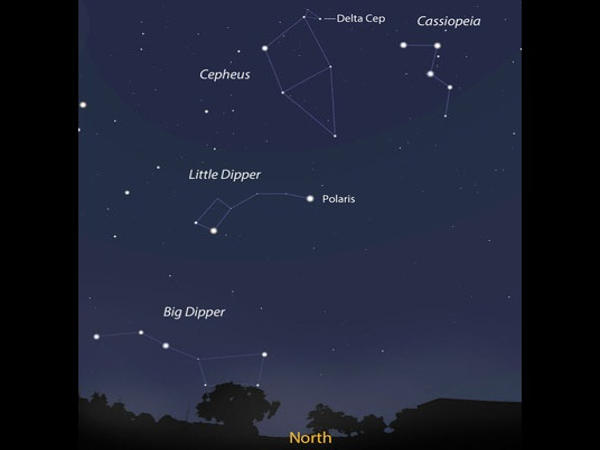Delta Cephei (δ Cep, δ Cephei) is a binary star system about 887 light-years away in the northern constellation of Cepheus, the King. It is the prototype of the Cepheid class of variable stars. At this distance, the apparent magnitude of the star is reduced by 0.23 as a result of gas and dust along the line of sight. Its period of 5.366 days makes it an attractive candidate for anyone anxious to obtain a star’s full change in brightness in a short period of time.
Delta Cephei, found by John Goodricke in 1784, was only the second Cepheid variable discovered. It is very important because its distance is extremely well known. Investigation of delta Cep’s heavenly position shows that the variable conveniently sits between two bright stars that shine at either end of its range of variability: zeta Cep at a magnitude of 3.6 and epsilon Cep at a magnitude of 4.2. This is partly because it is in a star cluster, close enough for the precise Hubble Space Telescope/Hipparcos parallaxes to give a good result. As a result, it is known as a “fundamental distance calibrator”, or absolute candle. Delta Cephei is a classical, or type I, Cepheid variable.
The only Cepheid variable closer to us is Polaris, the North Star, whose distance is still not exactly known. Because of its moderate brightness, δ Cephei should be easily visible from locations with dark skies, while it can be barely visible, or not visible at all, from skyes affected by light pollution.

As well as being the prototype of the Cepheid class of variable stars, Delta Cephei is among the closest stars of this type of variable to the Sun, with only Polaris being nearer. Due to its eccentric orbit, Delta Cephei is sometimes further and sometimes closer to its companion. Its variability is caused by regular pulsations in the outer layers of the star. It varies from magnitude 3.48 to 4.37, and its stellar classification also varies, from about F5 to G3. Delta Cephei’s eccentric orbit thus points to interactions between the two stars due to tidal forces that occur when they are close to each other. The pulsation period is 5.366249 days, with a rise to maximum occurring quicker than the subsequent decline to minimum.
Delta Cephei is emitting around 2,000 times the Sun’s luminosity. This is producing a strong stellar wind, which, with the pulsations and shocks in the star’s atmosphere, is ejecting mass at the rate of (1.0 ± 0.8) × 10–6 solar masses per year. This is the equivalent to the mass of the Sun roughly every million years. As the scientists from Geneva and Baltimore measured Delta Cephei’s pulsations with the Hermes spectrograph, installed at the Mercator telescope based on La Palma, one of the Canary Islands, an unexpected signal was detected. The matter is flowing outward at a velocity of about 350 km s–1. This expelled gas forms a nebula about one parsec across, centered on Delta Cephei, and contains 0.07–0.21 solar masses of neutral hydrogen. A bow shock is being formed where the stellar wind is colliding with the surrounding interstellar medium.
Informtion Source:
















